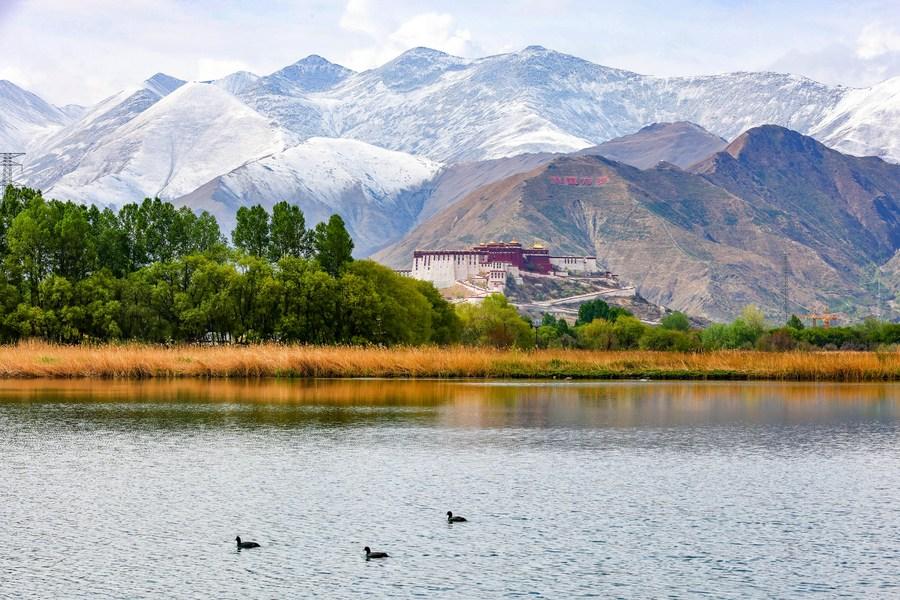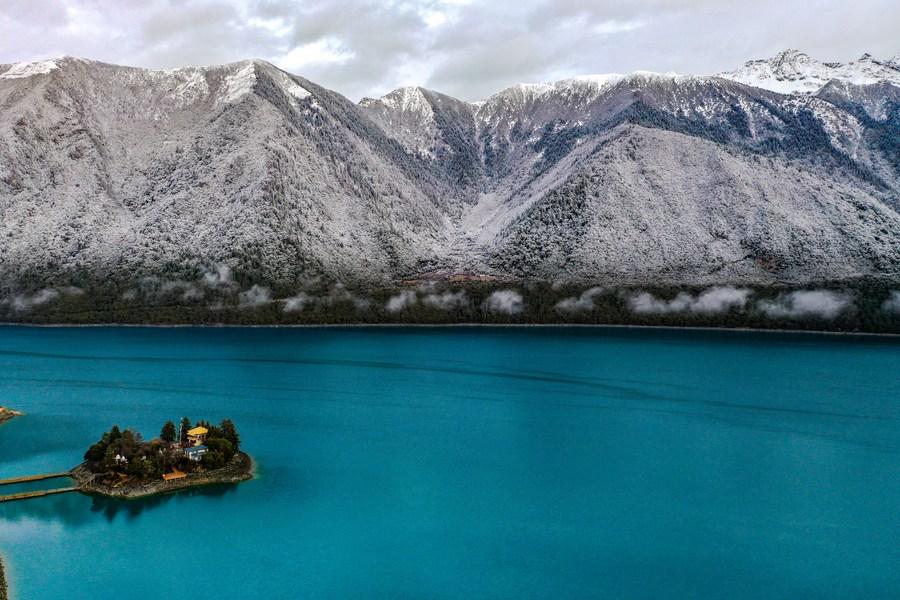Source:Xinhua 2023-05-25

This photo taken on May 12, 2023 shows the Lhalu wetland in Lhasa, southwest China's Tibet Autonomous Region. (Xinhua/Jiang Fan)
by Xinhua writers Chu Yi, Shen Hongbing, Zhai Yongguan
LHASA, May 23 (Xinhua) -- In front of a carving on the peaceful liberation of Tibet, Dainzin Lhamo, 58, was lost in a sea of memories.
"Reflecting upon the past, one cannot help but acknowledge that it was the peaceful liberation of Tibet over 70 years ago that paved the way for the blissful life we enjoy today," she said.
Hailing from a village in Comai County, Dainzin Lhamo is a descendant of serfs from old Tibet. The recollections of her parents vividly depict life in old Tibet, where over 100 serfs inhabited the village, grappling with scarcity and deprivation.
She vividly recalled her parents' dwelling, a feeble structure supported by a single pillar, precariously situated adjacent to the cattle enclosure. This makeshift dwelling offered minimal respite from the hardships of life, failing to shield the family from rain, snow, or the biting chill of the wind.
"My father would often recount that his entire family never knew a single day of abundance," Dainzin Lhamo said.
GIANT LEAP
In old Tibet, the three major stakeholders -- officials, aristocrats and higher-ranking lamas -- and their agents made up about 5 percent of the population but owned almost all of the land, pastures, forests, mountains, rivers and flood plains, and most of the livestock.
Serfs and slaves, who accounted for 95 percent of the local population, had no means of production or freedom of their own.
"Feudal serfdom in old Tibet inflicted a grave assault on human dignity, flagrantly disregarded fundamental human rights and posed a fundamental impediment to social progress within the region. The archaic system stood in opposition to the prevailing tide of advancement both in China and across the globe," said Xiao Jie, deputy director of the institute of contemporary studies of the China Tibetology Research Center.
On May 23, 1951, the 17-Article Agreement was signed by the central government and the local government of Tibet on the peaceful liberation of Tibet.
Since then, the people of Tibet have broken free from the fetters of invading imperialism for good, and embarked on a bright road of unity, progress and development along with all the other ethnic groups in China.
In March 1959, democratic reform was launched in Tibet and feudal serfdom was finally abolished. In September 1965, the First Session of the First People's Congress of Tibet was convened, proclaiming the founding of the Tibet Autonomous Region.
With regional ethnic autonomy established and through the socialist transformation of agriculture and animal husbandry, Tibet embarked on the road of socialism.
The peaceful liberation of Tibet marks an epoch-making historical milestone, bringing about a profound turning point for Tibet, said Benba Lhamo, a researcher at the National Institute of International Strategy under the Chinese Academy of Social Sciences.

This aerial photo taken on March 19, 2023 shows the scenery of Basum Lake after snow in the city of Nyingchi, southwest China's Tibet Autonomous Region. (Xinhua/Jiang Fan)
UNPRECEDENTED FEATS
Tibet has prioritized enhancing people's livelihoods as the foundation of its economic and social development.
Since the 18th National Congress of the Communist Party of China in 2012, over 80 percent of its annual fiscal revenue has been allocated for the improvement of people's livelihoods, and a comprehensive system for people's well-being encompassing education, healthcare and elderly care has been established.
In 2022, Tibet's gross domestic product soared to 213.26 billion yuan (about 30.3 billion U.S. dollars), a remarkable increase of over 1,650 times compared to that in 1951.
Notably, Tibet achieved record-breaking agricultural output last year, with grain production surpassing 1.07 million tonnes.
Significant advancements were also made in healthcare. The region boasted a commendable number of medical and health institution beds, reaching 5.49 per 1,000 people, while the number of health technicians per 1,000 people stood at 7.18 last year.
Moreover, the average life expectancy in Tibet rose from 35.5 years prior to the peaceful liberation to 72.19 years.
Education has been a key focus in Tibet, as the region successfully implemented a 15-year publicly funded education system covering kindergartens through high schools. Tibet has built 3,339 schools, with a total of 922,000 students.
Today, the people of all ethnic groups in Tibet have equal access to development opportunities, and the region is enjoying comprehensive social progress, said Samer Khair Ahmed, a China expert from Jordan. Enditem
(Xinhua correspondents Bai Shaobo, Li Jian and Wang Zehao also contributed to the story.)